Jennifer S. Kelly's Blog, page 2
April 3, 2020
Today in Racing History — April 3rd
[image error]100 years ago, 1920 — The Maryland state legislature was considering the Burke Measure, also known the Burke-Janney law, creating the Maryland Racing Commission and putting racing in the state of Maryland under more state oversight. Once the bill passed, the state’s racetracks — Havre de Grace, Bowie, Pimlico, and Laurel — shared 100 racing days a year and were required to pay $6,000 a day in taxes to the state.
Read more about that in Sir Barton and the Making of the Triple Crown, chapter 11.
75 years ago, 1945 — Racetracks in the United States were dark on orders of the War Department. In England, however, Ascot was open, leaving American soldiers wondering why the Brits were able to race when racing here had been closed for the duration.
Read more in the Louisville Courier-Journal, April 3, 1945.
50 years ago, 1970 — Peter Fuller’s pursuit of Dancer’s Image’s share of the 1968 Kentucky Derby purse continues in Kentucky.
Read the article in the Louisville Courier-Journal, April 3, 1970.
March 22, 2020
Shut Down by the Spanish Flu
The dark, dank trenches of France behind him, imagine your doughboy stepping off a ship onto American soil. For the first time in many months, he is back in his own country, but he can’t come home to you just yet. Instead, he reports to his unit’s headquarters and finds himself surrounded by frantic doctors and nurses trying to squelch an epidemic.
In the late fall of 1918, as the Great War was winding down and American soldiers were boarding ships back to the United States, they brought with them an unwelcome gift: a new and more virulent strain of the Spanish flu. The previous spring had seen an outbreak of the same flu, but the intervening months had mutated the virus into something more deadly, striking the young and healthy as it spread among soldiers and then civilians so quickly that it overwhelmed cities.
In 1918, the horse racing world was much smaller than it is today. By the fall, events like the Kentucky Derby and Saratoga’s late summer meet had already come and gone, but meets at Latonia in northern Kentucky and Laurel in Maryland were at the mercy of measures that governments had to take to stem the tide of this deadly epidemic.
No, No, You Can’t Go
By early October, newspapers were awash in reports about the outbreak of this new strain of the flu, detailing the rise in cases as well as the measures being taken to treat those stricken. Wartime policies had prevented the spread of information about the virus’s movements until it was too late in some areas. The city of Philadelphia had gone ahead with a parade celebrating Liberty Bonds, which the government had sold to help fund the war effort. Days later, a spike in reported flu cases were a direct result of that decision.
That realization led local authorities in both Maryland and Kentucky to limit public gatherings in that crucial first part of October. That meant that both Laurel and Latonia would have to wait. This delayed a number of stakes races, including the match race between two-year-olds Billy Kelly and Eternal that was to decide the best juvenile of the year. The Daily Racing Form updated readers on the latest regarding each meet, optimistically reporting each time the ban might be lifted.
Sound Familiar?
Finally, the bans were lifted in late October, allowing each meet to go forward. Both were delayed by two or three weeks, but racing resumed nevertheless and quickly returned to normal. The Spanish flu would linger for another six months, with another outbreak in the spring of 1919. By that point, the virus had again evolved to a less serious version, marking the end of a nightmarish epidemic in the United States. No corner of the country had been untouched by the Spanish flu: even President Woodrow Wilson endured his own case as he prepared to sign the Treaty of Versailles.
Our ability to diagnose viral infections and understand how they spread is years from where it was a century ago. This knowledge means that we know what we need to do to deal with an epidemic like the COVID-19, including something unprecedented for most of us: the cancellation or postponement of our favorite sports. While we wait for the First Saturday in September and mourn the loss of familiar joys, let us remember that racing eventually returned to normal in 1918 and that will happen again in 2020.
December 11, 2019
The Degenerates’ Gift-Giving Guide!
Pete Fornatale and Jonathon Kinchen have a brilliant podcast called the In the Money Podcast, where they talk about handicapping, racing previews, and more. I recently appeared on the show to talk about books, artwork, and other gift ideas for the horse racing person in your life. Here are the books that I recommended!
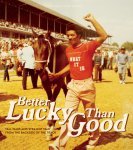
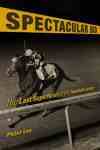


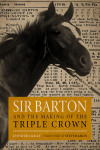
Better Lucky Than Good is a collection of stories directly from people who work in all sectors of horse racing in the Louisville, KY area. From grooms and hot walkers to residents of the neighborhoods around Churchill Downs, the book shares perspectives on the sports directly from those who live it and breathe it every day.
Spectacular Bid: The Last Superhorse of the Twentieth Century by Peter Lee tells the story of how an inexpensive steel gray colt became a speedy phenomenon, only missing the Triple Crown by a safety pin. If you don’t know the story of the Bid, you need to read Lee’s exploration of the career of this legend.
Justify: 111 Days to Triple Crown Glory by Lenny Shulman explores Justify’s 2018 Triple Crown from the words and perspectives of the people who lived it; everyone from Bob Baffert to John and Tanya Gunther add to the story of how this brawny colt came out of nowhere to take down America’s most prestigious prize. Shulman had unprecedented access throughout Justify’s run and uses that access to give you a complete picture of this once-in-a-lifetime horse.
The Travers: 150 Years of Saratoga’s Greatest Race by Brien Bouyea and Michael Veitch chronicles the history of the Midsummer Derby, a race that carries almost as much gravitas as the Triple Crown races themselves. From Man o’ War to Native Dancer, Whirlaway to Arrogate, you will find photos and more on every running of the Travers as Bouyea and Veitch regale you with stories and details of each year’s renewal. You can read more about the book here.
My last recommendation comes from the very computer I’m typing this blog post on: Sir Barton and the Making of the Triple Crown! Nearly six years of work went into researching and writing the story of Sir Barton, from his purple pedigree to his lasting impact on the sport. I hope you will consider picking up a copy for yourself or for someone on your list! (Want a signed copy? Order here!)
Here is the link to the Degenerates’ Gift-Giving Guide! So many great gift ideas from a variety of sources in this nearly two-hour podcast. This surely will help you finish your holiday shopping! I appear about twelve minutes in. Happy Holidays!
December 3, 2019
It’s Giving Tuesday!
Happy Giving Tuesday! With Thanksgiving behind us and the winter holidays in front of us, Giving Tuesday is a day to celebrate those who make a difference in our communities by giving a little to help them continue their missions. If you are looking for racing-related charities to give to today, look no further! Here is a list of some worthwhile organzations doing great work in all aspects of the sport:
National Museum of Racing and Hall of Fame — Today, they’re looking for 452 donors to give a little or a lot in honor of each of their 452 honorees.
Thoroughbred Aftercare Alliance — This organization provides a list of aftercare organizations accredited by the TAA if you are looking for a local equine charity.
Grayson-Jockey Club Research Foundation — The GJC conducts research that is fundamental for solving ongoing health issues for all horses. They have funded over 300 projects at a number of universities across the world.
Permanently Disabled Jockeys Fund — The PDJF relies solely on donations to provide financial assistance to jockeys who have suffered catastrophic on-track injuries.
Belmont Child Care Association — The BCCA provides childcare for all workers at Saratoga, Aqueduct, and Belmont Park. Since most workers rise quite early and can work late into the day, this organization provides both childcare and early childhood education to these racetrackers.
Backside Learning Center — The BLC at Churchill Downs provides educational opportunities to both employees and their families. They offer everything from ESL education for both children and adults to after-school and summer programs for the children of Churchill Down’s equine workers.
Thoroughbred Charities of America — The TCA provides grants to nonprofit organizations that benefit the thoroughbred and the people who work with them. You can give to the TCA and know that the funds will go to any number of organizations within the industry, including research, aftercare, therapy, and equine employee assistance.
Saratoga WarHorse — The Saratoga WarHorse program provides equine-assistance therapy to veterans with Post-Traumatic Stress. Working with the horses can provide physical, mental, and emotional relief from the symptoms of PTS for these people who have given so much to our country.
These are only a few of the many organizations out there, but I know all of these will appreciate any and all donations. Big or small, whatever you can give will find its use in many worthwhile initiatives that benefit both the horses and the humans of our sport. I hope you will consider giving on this Giving Tuesday!
December 2, 2019
A Year of Gratitude
Churchill Downs, Pimlico Race Course, Saratoga Race Course, Kentucky Downs, Keeneland Race Course.
The Kentucky Derby Museum, the Keeneland Library, Audley Farm, Long Branch Historic House and Farm, and the National Museum of Racing and Hall of Fame.
From Kentucky to Alabama to Maryland to Virginia to New York, thousands of miles via my trusty minivan or leaving on a jet plane.
2019 has been quite a year. When I started writing Sir Barton’s story, I had just quit my adjunct teaching position at UAH. My kids were 3 and 7. I had no publisher and no guarantee that I would find one. I knew no one in the horse racing industry and operated on the faith that a book on America’s first Triple Crown winner was something that the sport wanted. As a historian, I knew this book was needed, but how it would be received, heck, how I would be received was a giant question mark. I felt like I was nobody, but I knew I had the tenacity, the perseverance, and the skills necessary to do the job. I plunged headlong into the writing with nothing but my husband’s support and his trust that I could do this thing.
The first time I went to the Keeneland Library, I met Cathy Schenk, who kindly helped me learn my way around and start the daunting task of winding my way through their research on Sir Barton. When I returned a second time to continue my research, Cathy said she knew I would finish this because I had come back. “So many writers do not once they find how intimidating this can be,” she explained. I made several more trips to Keeneland and now feel like I’m walking into the bar on Cheers each time I visit.
I spent hours on the Daily Racing Form archive and Newspapers.com. I wrote emails and requested information from anyone who I thought might have something helpful. I requested so many books from my library that the librarian in charge of interlibrary loan asked what I was working on. I tracked down family members from all of the major players. I started social media accounts and worked on connecting to other fans of the sport in the hopes of ginning up interest in my project. I started this blog and wrote a book proposal, sending it out to a number of agents (and the same number of rejections). Finally, I was able to connect with the University Press of Kentucky and their wonderful team. I finished writing on October 3, 2017.
Six months of revising and editing and furiously collecting photographs later, I submitted the manuscript. I somehow got the great Steve Haskin to write the foreword. I counted nearly 1000 citations, all meticulously documented in Chicago style. I resolved the copy edits and then proofread the book at least twice over after I received the galleys. I cried when I received the cover and then again when I saw the galleys. I cried harder when a box landed on my doorstep on April 2, 2019, with actual copies of Sir Barton’s story. Nearly six years after I got the idea to write this book, it was reality. Tangible. And it had my name on it.
People ordered it. They read it. They reviewed it. They came to hear me talk about Sammy, sign a book, and then chat. I had the privilege of meeting people I admired and getting to know as many people as I could. My copy of the book is covered in signatures: Steve Haskin, Bob Baffert, Mike Smith, Steve Asmussen, Jean Cruget, Chris McCarron, Steve Cauthen, Caton Bredar, and more. (Still missing Steve Byk!) This year has been humbling and thrilling and more, experiences that I shared with my husband and kids (now 8 and 12) whenever I could.
As 2019 winds to a close, I look forward to a new year and a new project. The Sir Barton Project will be rolled into a portfolio site as I work on what’s next. More books and more research are in my future, as I work to preserve the history of horse racing, especially the Triple Crown. I look forward to chances to collaborate and to write, whatever I can do to contribute to the sport I love.
As 2019 draws to its inevitable conclusion, I cannot express my gratitude to every person who made this possible, who picked up a book, who reached out to me, who shared their love for the horses and the sport, and who helped me share Sir Barton’s story with the world. I sit in awe of you all, with tears of joy and a full heart. Thank you for being a part of this amazing year!
Finally
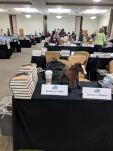
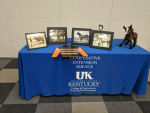



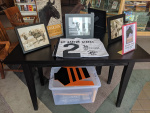
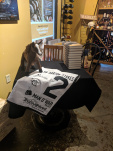

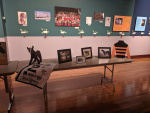


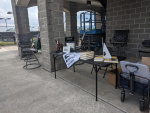

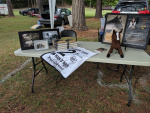
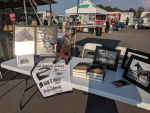
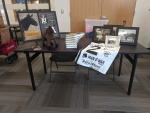
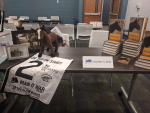
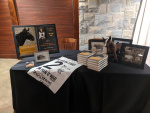
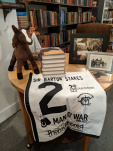
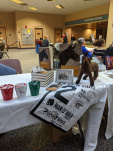
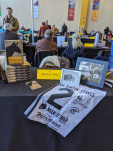
November 5, 2019
A Century Ago, A Schism
[image error]By early November, 1919 had become a year of mixed blessings for jockey Johnny Loftus. He had been aboard Man o’ War for all of his victories — and his lone defeat. Loftus had ridden winners for a number of racing’s top stables and trainers, everyone from Sam Hildreth to H.G. Bedwell. He had won a Kentucky Derby on Sir Barton but also lost the Dwyer Stakes to Purchase, who Loftus also had ridden to victory that year. Loftus had been set down for rough riding, yet he also had served as trainer Louis Feustel’s go-to rider for a fractious and challenging Man o’ War. With the year winding down, Loftus was looking forward to 1920, possibly his final year in the saddle. Years of fighting his weight left the jockey ready to consider what’s next. In the meantime, he was ready to finish out 1919 on a high note.
The Autumn Handicap on November 5th would prove to be anything but.
[image error]Sir Barton came into the race as the heavyweight, laden with 132 pounds. Sailor was the lightweight at 96, with Mad Hatter, a horse on a hot streak, carrying 111 pounds despite his recent wins. Pimlico had absorbed heavy rain the night before, but winds had started to dry the surface, leaving the track cuppy, especially at the rail. Sir Barton had proven himself to be more than capable of handling an off track, but the Dwyer demonstrated that the colt had trouble running on the rail on a drying track. Loftus had ridden Sir Barton in the Dwyer so he should have been familiar with the colt’s difficulty in handling that type of track. But the jockey had no other mounts that day, opening up the possibility that he was not aware of how the surface was playing.
Bridesman took the lead at the start, with Sir Barton’s stablemate Milkmaid challenging. Mad Hatter stalked the pace just behind the two leaders, Sir Barton running behind him. As they hit the six-furlong mark, Mad Hatter made his move out in the center of the track as Loftus asked Sir Barton for more down on the rail. Mad Hatter passed Bridesman, Fator looking for Sir Barton to press for the lead as well. Instead, Loftus and his mount labored behind Bridesman, the heavy impost and cuppy track slowing Sir Barton’s move. When it was clear that they would not catch Mad Hatter, Loftus eased Sir Barton, who finished twelve lengths back of the winner. It was a dull performance from a horse who had been asked to carry 132 pounds after a long campaign. But to finish third by twelve lengths to a horse he had already beaten? Trainer H.G. Bedwell was livid.
What happened next opened up a schism that rocked the Ross Stable and may have changed one man’s life for good. Read more in Chapter 10 of Sir Barton and the Making of the Triple Crown.
September 25, 2019
A Night at the Red Mile
Thanks to my friend Judy Jones, herself a talented artist and horse lover, I was able to pop into the Red Mile, a one-mile harness racing track located near the University of Kentucky in Lexington. What an evening!


I have been a horse racing fan for 30 years, but I have never been to live harness racing. Living in Alabama does not allow for many opportunities to what any kind of racing that isn’t driven by a car so I take my chances to see live racing anytime I can! I happened to be in Lexington this past weekend for the Heartland Book Festival so I took this chance to visit the Red Mile. Even though the card was a short one, those six races were fascinating to watch.


The thunder of hooves is familiar, but the strides that the horses use and the times they log are unfamiliar to this long-time fan of all things horse. I was fascinated by the way the trotters and pacers stayed in stride and wondered how their trainers teach their horses to maintain their trot even while accelerating. Watching their legs move, the drivers behind them working and pushing much like a jockey but from a precarious perch on two wheels behind them, was simply mesmerizing. I am left with the feeling that I must learn more!
Fascinating also was the history of the track I was at. The Red Mile is the second oldest harness racing track in the world! Opened in 1875, the Red Mile hosts the Kentucky Futurity, which is one of the three legs of the Trotting Triple Crown, with the Hambletonian and the Yonkers Trot being the other two. The track now hosts Keeneland’s off-track-betting as well. The upcoming Kentucky Futurity is part of the 2019 Grand Circuit, where the elite of the harness racing scene will descend upon the track for the final races of the year. If you can make it out for these races, I highly recommend it.
[image error]Lastly, I discovered that the Red Mile also features this Round Barn, originally used as an exhibition hall and then to house horses and tack before becoming an event venue. If I lived in the Lexington area and were planning a wedding or other big to-do, I would definitely look at this beautiful structure. From the outside, it has a distinctive look, evocative of the era of the track’s origins. From the inside, it looks like a cozy vintage space for any get-together. Definitely take a look around if you’re ever in the area.
Thank you, Judy, for showing me around this wonderful track, another race track ticked off my list!
August 28, 2019
He Nipped Gnome by a Nose
Gnome was a horse on a hot streak. Coming off a win in the Champlain Handicap, the chestnut colt counted the great Exterminator amongst those he had beaten at Saratoga that August. Now, still the beneficiary of a break in weights, Gnome faced the barrier alongside Sir Barton.
Sir Barton had started August with a track record in the Saratoga Handicap at a mile and a quarter. He had then run that distance again at Fort Erie, winning easily, but now he was back at Saratoga for this race, the Merchants and Citizens Handicap. Again laden with 133 pounds, Commander Ross’s champion horse stood at the barrier, Gnome to his left and Jack Stuart to his right. Ahead lay a mile and three-sixteenths. One more race, another step closer to a potential meeting with the juggernaut that was Man o’ War.
Ninety-nine years ago, Sir Barton and Gnome met on the Saratoga oval for a record-setting performance, a finish so close that only the judges could determine the winner. Luckily photographer Charles Cook snapped the combatants as they battled to the wire.
[image error]
A world record, a close finish, and a die cast for a match race. Read more about Sir Barton’s turn in the Merchants and Citizens Handicap in Sir Barton and the Making of the Triple Crown (Chapter 13).
August 22, 2019
Books of Note: Celebrate Travers 150 With THIS!
The 150th edition of the Travers Stakes, the Midsummer Derby for three-year-olds, will be run at Saratoga Race Course this Saturday. The Travers trophy has legendary origins of its own, as I discussed here, but 2019 features something new for racing fans: an epic book on the history of the Travers Stakes, written by Brien Bouyea and Michael Veitch.
[image error]Bouyea, communications director at the National Museum of Racing and Hall of Fame, and Veitch, a longtime writer for the Saratogian, chronicle each Travers, dating all the way back to its first edition in 1864. Named for William Travers, the first president of Saratoga Race Course, the race has become one of the most prestigious races for three-year-olds in North America, the perfect destination for any top-name contender in the second half of the year. This book is not only essential for any fan of horse racing, but it is also one of the best references ever produced. If these two gentlemen could turn their attention to the Triple Crown races next, I can guarantee that you would want to have all of these books on your shelf. This Travers book is gorgeous, hardbound and printed with high-quality paper, highlighted by Greg Montgomery’s wonderful artwork.
The Travers: 150 Years of Saratoga’s Greatest Race is $65 (including shipping). You can order from the link or, if you’re in the Saratoga Springs area, you can purchase the book at the National Museum of Racing and Hall of Fame or any of their upcoming events.
The field for this year’s Travers includes my picks Tacitus and Code of Honor.
Owendale – Florent Geroux – Brad Cox – 6-1
Code of Honor – John Velazquez – Shug McGaughey – 4-1
Highest Honors – Luis Saez- Chad Brown – 10-1
Laughing Fox – Ricardo Santana, Jr. – Steve Asmussen – 30-1
Everfast – Martin Chuan – Dale Romans – 30-1
Tacitus – Jose Ortiz – Bill Mott – 5-2
Mucho Gusto – Joe Talamo – Bob Baffert – 6-1
Chess Chief – Mike Smith – Dallas Stewart – 30-1
Looking at Bikinis – Javier Castellano – Chad Brown – 10-1
Scars Are Cool – Tyler Gaffalione – Stanley Hough – 30-1
Endorsed – Joel Rosario – Kiaran McLaughlin – 15-1
Tax – Irad Ortiz, Jr. – Danny Gargan – 6-1
Catch the race Saturday on Fox (5 – 6 pm Eastern). Fox Sports 2 will broadcast the Travers undercard from 11:30 am to 5 pm Eastern.
Now, in celebration of this Saturday’s 150th Travers Stakes, here is the greatest Travers ever.
August 12, 2019
This Week!
[image error]I have the privilege of visiting Saratoga Spring, New York and the National Museum of Racing and Hall of Fame this weekend for two events:
Author Talk: Sir Barton and the Making of the Triple Crown — Friday, August 16th at 6:30 pm. After my presentation, I will be signing books.
Saturday Morning Socials — Lenny Shulman, author of Justify: 111 Days to Triple Crown Glory, and I will be signing books at the Museum before the day’s races at Saratoga. (9:30 – 11:30 am)
I hope you can come by and see me! I would love to talk about all things Sir Barton and racing history with you!



